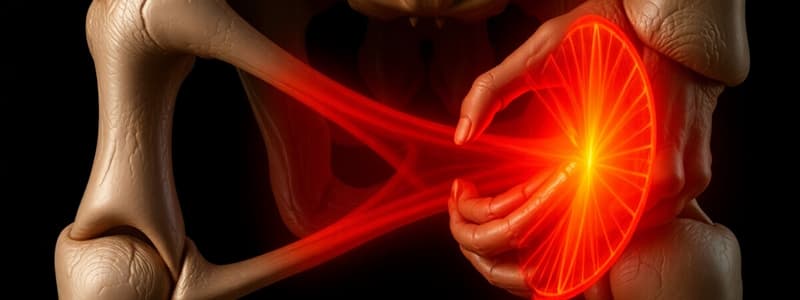Podcast
Questions and Answers
What is the coefficient of static friction between the bones in the knee joint?
What is the coefficient of static friction between the bones in the knee joint?
- 0.016
- 0.030
- 0.009
- 0.020 (correct)
Which component primarily makes up the extracellular matrix of articular cartilage?
Which component primarily makes up the extracellular matrix of articular cartilage?
- Type I collagen
- Keratin
- Type II collagen (correct)
- Elastin fibers
What are the coefficients of kinetic and static friction listed for the knee joint?
What are the coefficients of kinetic and static friction listed for the knee joint?
- μs = 0.010, μk = 0.012
- μs = 0.003, μk = 0.001
- μs = 0.020, μk = 0.010
- μs = 0.020, μk = 0.016 (correct)
What is the primary function of articular cartilage?
What is the primary function of articular cartilage?
What percentage of water makes up the wet weight of the extracellular matrix in articular cartilage?
What percentage of water makes up the wet weight of the extracellular matrix in articular cartilage?
What is the primary function of synovial fluid in joints?
What is the primary function of synovial fluid in joints?
How does kinetic friction affect synovial joints during movement?
How does kinetic friction affect synovial joints during movement?
What distinguishes static friction from kinetic friction in synovial joints?
What distinguishes static friction from kinetic friction in synovial joints?
Which of the following correctly describes the role of articular cartilage?
Which of the following correctly describes the role of articular cartilage?
What is a common result of wear on joint surfaces?
What is a common result of wear on joint surfaces?
What is a significant mechanical failure mode for cartilage?
What is a significant mechanical failure mode for cartilage?
Which of the following factors contributes to the aetiology of osteoarthritis?
Which of the following factors contributes to the aetiology of osteoarthritis?
Which type of friction is present when surfaces are at rest with respect to each other?
Which type of friction is present when surfaces are at rest with respect to each other?
Flashcards
Static Friction in Joints
Static Friction in Joints
The resistance to movement between two surfaces that are not moving relative to each other in a synovial joint.
Kinetic Friction in Joints
Kinetic Friction in Joints
The resistance to movement between two surfaces that are moving relative to each other in a synovial joint.
Synovial Fluid
Synovial Fluid
Fluid in synovial joints that reduces friction between bones.
Articular Cartilage
Articular Cartilage
Signup and view all the flashcards
Joint Lubrication
Joint Lubrication
Signup and view all the flashcards
Static Friction
Static Friction
Signup and view all the flashcards
Kinetic Friction
Kinetic Friction
Signup and view all the flashcards
Synovial Joints
Synovial Joints
Signup and view all the flashcards
Friction
Friction
Signup and view all the flashcards
Lubrication
Lubrication
Signup and view all the flashcards
Joint Movement
Joint Movement
Signup and view all the flashcards
Study Notes
Musculoskeletal System, Nervous System & Bioelectricity, MNB.8 Friction in Synovial Joints
- Learning Outcomes: Differentiate static and kinetic friction, describe cartilage structure/composition relating to mechanical behavior, explain synovial fluid's role in normal joints, describe joint lubrication (fluid film and boundary), describe mechanical cartilage failure modes, discuss clinical relevance of permeability/tension in cartilage function, describe osteoarthritis aetiology, and differentiate rheumatoid arthritis from osteoarthritis.
Articulation of Synovial Joints
- Friction: Frictional forces resist relative motion, wear occurs due to mechanical or chemical action.
- Synovial Joints: These are the most common and movable joints, including the shoulder and knee. They have articular cartilage and synovial fluid, enclosed in a fibrous capsule.
Friction
- Definition: Friction is the force exerted by a surface as an object moves across it or tries to move across it.
- Lubrication: Reduce friction in the body with saliva, mucus, tears, and synovial fluid.
Static and Kinetic Friction
- Static Friction: Effective between surfaces at rest; must be overcome for motion (e.g., muscle tension or gravity).
- Kinetic Friction: Effective between surfaces in relative motion; opposes motion, causing wear, generating thermal energy, and reducing efficiency.
- Friction Plot: Illustrates the relationship between applied force and friction.
Static and Kinetic Friction Table
- Fs = μs mg where Fs = static friction, μs = coefficient of static friction, m = mass of the block, g = acceleration due to gravity, and FN = normal force.
- Fk = μk mg where Fk = kinetic friction and μk = coefficient of kinetic friction. Knee joint example: μs = 0.020 and μk = 0.016
Joint Lubrication Mechanisms
- Hydrodynamic Lubrication: Synovial fluid separates bearing surfaces. Load bearing is supported by pressure of fluid film; fluid forms wedge shape during movement creating hydrodynamic lift.
- Boundary Lubrication: Associated with close contact between surfaces (~10-8 m); a surface lubricant protects cartilage; important for stationary joints and under high loads.
- Mixed Lubrication: Transition between boundary and fluid film lubrication; important for reducing friction as loads reduce and movement starts.
Articular (Hyaline) Cartilage
- Structure: Thin layer (2-4 mm) of dense, translucent connective tissue covering the ends of articulating bones. It lacks blood vessels, nerves, and lymphatics, having limited repair ability.
- Function:
- Distributes loads by increasing contact area.
- Provides a bearing surface with low friction and wear (µs of 0.01 and µk of 0.003).
- Extracellular matrix: Primarly composed of water (~75% wet weight), type II collagen (20%), proteoglycans (5%, primarily aggrecan), and <1% hyaluronic acid.
Cartilage Tension
- Mechanical Stress: Cartilage experiences tension, compression, and shear in its environment.
- Physiological Load: Load ranges from 5-8 MPa during walking to 18 MPa during activities like rising from a chair.
- Compression: Negatively charged proteoglycans push closer, creating larger repulsive forces, increasing cartilage stiffness.
- Impact Loading: Cartilage stiffness rapidly increases with impact loading.
Cartilage Permeability
- Failure Prevention: Low permeability prevents fluid from quickly leaving the cartilage.
- Load-Strain Relationship: Permeability decreases, and fluid flow into/out of the cartilage decreases with increasing load and strain.
Synovial Fluid
- Properties: Clear viscous liquid resembling egg white; produced in the synovial membrane.
- Composition: Contains water, hyaluronates, and proteoglycans
- Function:
- Lubricates articulating joints.
- Combination with cartilage makes it 3x more slippery than skating on ice.
- Evenly distributes pressure across articular surface.
- Avascular Support: Facilitates oxygen and nutrient transport to the cartilage.
- Viscosity: Decreases with increased stress; this change in viscosity is important in rapid joint movement.
Synovial Fluid Reserve
- Load Application: Joint loading increases interstitial fluid pressure.
- ECM Flow: Increased pressure causes fluid to flow out of the ECM.
- Load Removal: Fluid flows back into the ECM, restoring its original shape
Degenerative Joint Diseases
- Definition: General name for diseases affecting joints and joint mobility, including osteoarthritis and rheumatoid arthritis.
Rheumatoid Arthritis
- Type: Autoimmune disease affecting joints, commonly woman vs. men
- Symptoms: Often symmetrical, periods of remission and exacerbation occur
- Stages:
- Initial attack, then swelling, and possible deformation, possibly ending in fusion of the joints.
Osteoarthritis
- Type: Chronic degenerative joint condition characterized by pain, stiffness, triggered by aging/wear and tear.
- Mechanism: Gradual cartilage breakdown, bone thickening, formation of bone spurs (osteophytes), bits of cartilage/bone floating in the joint space.
- Risk Factors: (e.g., obesity, genetics, joint injury)
- Common in knees, hips, hands, neck, shoulders, lower back
Studying That Suits You
Use AI to generate personalized quizzes and flashcards to suit your learning preferences.
Related Documents
Description
This quiz covers key concepts related to the musculoskeletal system, focusing on friction in synovial joints. Participants will differentiate between static and kinetic friction, discuss the composition of cartilage, and explore the roles of synovial fluid. It also addresses clinical relevance, including conditions like osteoarthritis and rheumatoid arthritis.




